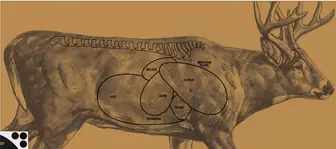|
The Kill Zone of North American Big Game Animals By Chuck Hawks How big a target is the heart/lung area of common male big game animals? That is a good thing to know if you are a hunter. The heart/lung that should be your target is irregularly shaped in three dimensions, of course, but for hunting purposes can be expressed as a circle within which you must be able to put your bullet to insure a clean kill on an animal standing more or less broadside to your shooting position. For example, an average whitetail deer weighing about 125 pounds, viewed broadside, has a heart/lung area generally estimated give you a circle of around 10" in diameter at which to shoot. If you can keep your bullet in a 10" diameter circle from a field position and you aim just behind the foreleg and about 1/2 of the way up from his brisket (or 1/2 of the way down from the top of his back), which basically marks the center of his heart/lung area, your bullet should find the animal's vitals.  Illustration of deer target courtesy of Brichwood Casey. This hold gives you some room for error, for if the bullet goes too far forward you may get the shoulder, at least crippling the animal so that it cannot escape. If the bullet goes high it may still get the top of the lung or the spine. If it goes low it may well take out the heart. Just don't hit too far back. Hit behind the lungs and the bullet goes into the abdominal cavity, which is not an immediately vital area. If your bullet hits too far back you are likely in for a long and probably futile chase. The animal will die hours or even days later in excruciating pain because you screwed-up. Even if you eventually catch up with and kill the animal you are in for a very smelly and messy field dressing experience. If you have an ounce of conscience you will end up wishing that you had never taken the shot. If you do not have a reasonable understanding of the internal shape and layout of the common North American four-legged herbivorous mammals, do some research on animal anatomy online or at a library. Then, if you live in an urban or other area where game is seldom seen, make it a point to drive out into the country and observe common domestic animals that are about the size of the game you intend to hunt. Study live sheep, goats, horses, cows, pigs and so forth of various ages and sizes to get an idea of their size and shape. They will likely be stockier or fatter than game animals of the same approximate size and type because they are better fed, but anatomically they are probably not that much different. Note that most animals are relatively narrow when viewed head-on, much as humans are when viewed from the side. The goal is to get an idea of the general size and conformation of prey animals and how they appear from various angles. If an animal such as a deer or elk is basically facing your position you want to put your bullet in the center of his chest, about where his neck joins his body, assuming that his head is up. If not, wait until it is. Avoid neck shots and never attempt a brain shot except in an extreme emergency. Those are small targets and animals constantly move their heads, which is completely beyond the hunter's control and can turn even a perfect hold into a wound or a miss. If an animal is angling away from your position, it is usually reasonable to imagine aiming at his body in such a way that the bullet will penetrate through his chest on a course for his offside shoulder. Do not, however, take raking shots that would send the bullet through the animal's guts to reach that offside shoulder. You don't want to field dress a gut shot animal. Wait for a better opportunity; that is part of being a responsible hunter. We've already said that an average whitetail buck gives you about a 10" diameter target. That deer measures perhaps 17" deep through the chest, measured from the top of his back to his brisket. Here are some top of back to bottom of brisket estimates for other common North American game animals taken from various sources, but primarily from Jack O'Connor's book The Hunting Rifle:
Given those external body measurements, here are some estimated "vital area circle" diameters that roughly correspond to the approximate (heart/lung) target area:
One thing that those numbers show us is that ordinary 9" economy paper plates can be used to simulate the size of the target that the deer and pronghorn hunter needs to be able to hit. These make inexpensive targets. The distance at which you can keep all of your shots on a 9" paper plate with your hunting rifle from field positions is your personal maximum effective range under ideal conditions (an easily visible target and a calm shooter). In the field your personal maximum effective range will usually be less because you will be shooting at a far less distinct target, you will probably be excited and you may also be winded from a long stalk or arduous hike. The vagaries of wind, uphill or downhill angles and altitude must also be considered in the field, as well as the trajectory of the cartridge and load that you are using. Never, in any case, shoot beyond the maximum point blank range of your cartridge. Good luck and please hunt responsibly. |